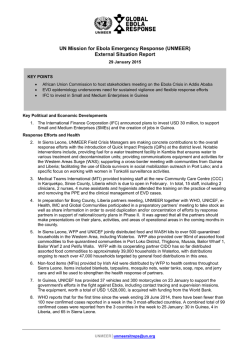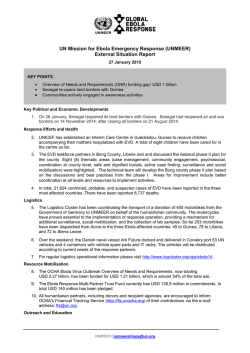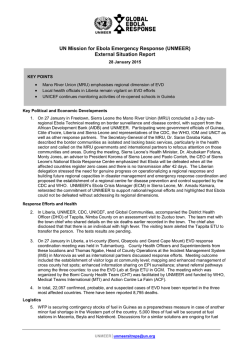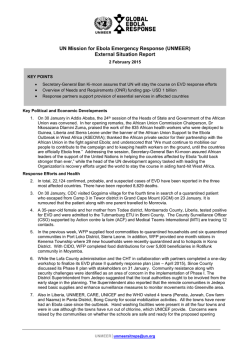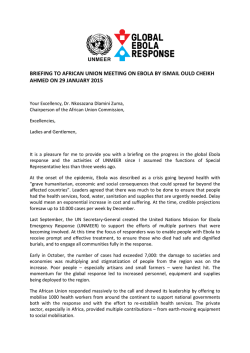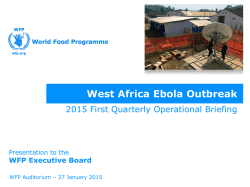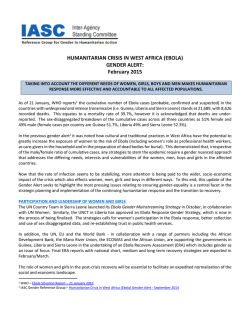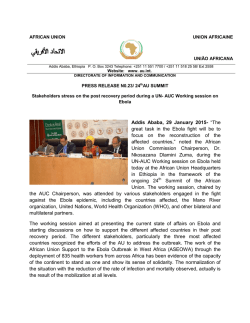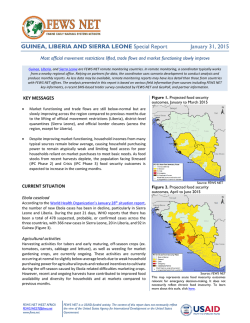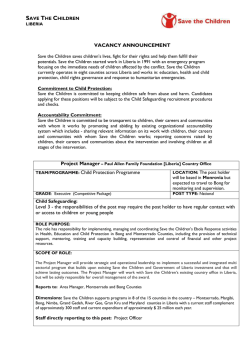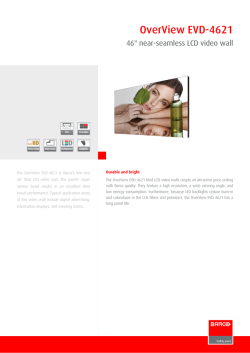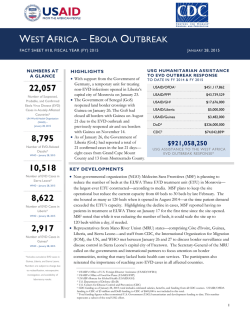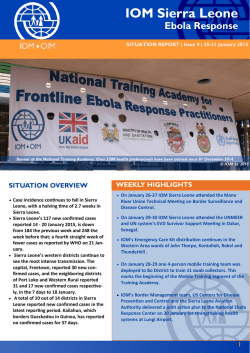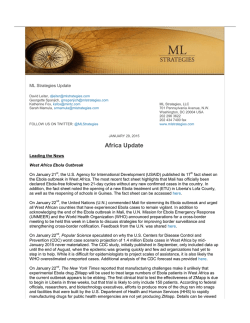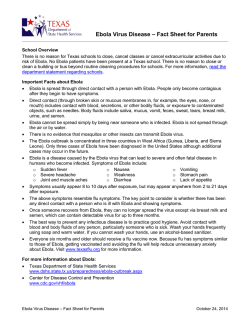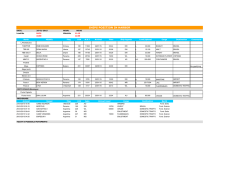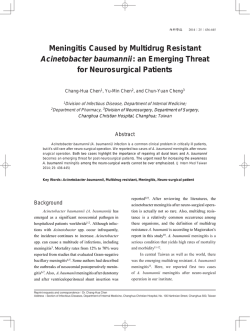
UN Mission for Ebola Emergency Response (UNMEER) External
UN Mission for Ebola Emergency Response (UNMEER) External Situation Report 30 January 2015 KEY POINTS SRSG Ahmed highlights EVD situation is still perilous Efforts underway to re-open schools in Liberia next week Governments and response partners sustain vigilance Key Political and Economic Developments 1. Addressing the Stakeholder Meeting on Ebola, convened by the Chairperson of the AU Commission in Addis Ababa on 29 January, SRSG Ould Cheikh Ahmed called on all leaders to maintain commitment until the goal of zero cases is reached. The SRSG underscored that situation is still perilous as Ebola is still present in more than 25 of the 66 districts, counties and prefectures in the region. 2. In advance of deploying Emergency Response Teams to support the Ebola fight, the OCHA Director of Operations for Humanitarian Affairs, Mr. John Ging, visited Sierra Leone, Guinea and Liberia to assess existing emergency coordination structure and met with UNDP and UNMEER colleagues, as well as NGOs and other response partners to discuss details of deployment. OCHA’s potential intervention is aimed to alleviate impact of the Ebola outbreak on various sectors. The officials will also recommend ways to enhance humanitarian response in the Ebola-hit countries. Response Efforts and Health 3. On 29 January in Sierra Leone, UNMEER joined the government and UNDP to launch a month-long exercise to revise the hazard payment policy for Ebola Response Workers (ERWs). The reclassification exercise will now ensure that response work is based on real risks, save cost and at the same time ensure that hazard pay is sustainable. A local ICT firm is assisting in computerizing a database workers, which may among others provide details that reflects the trends in the Ebola fight. The hazard incentive programme is funded by the World Bank, the African Development Bank and DFID, with technical guidance, implementation and coordination support provided by UNDP and UNMEER. 4. UNICEF has contributed approximately USD 3 million in the fields of Communication & social mobilization, health, education, the WASH and protection since the emergence of EVD in Mali. Even though Mali has successfully contained its Ebola outbreak, USD 5 million is still needed to continue the implementation of prevention activities due to the risk of recontamination from the neighboring countries. 5. Following a rapid assessment of health facilities in Rivercess, Liberia carried out by UNMEER and partners on 20 January, UNMEER organized the delivery of 1,200 kg of medical items that were handed to the CHT for St Francis Hospital in Rivercess County. These items are part of UNICEF’s support to the Ministry of Health and Social Welfare (MOH&SW) in the county. 6. UNMEER/WHO, chaired the regular partners’ meeting in Grand Cape Mount County, Liberia. The meeting focused on the status of implementation of interventions in support of the County EVD phase II plan, assessment of communities and services, in particular health and WASH facilities along the borders with Sierra Leone, integrated active case searching/contact tracing, social mobilization and restoration of health services. 7. In total, 22,101 confirmed, probable, and suspected cases of EVD have been reported in the three most affected countries. There have been reported 8,818 deaths. Logistics UNMEER│[email protected] 8. WFP is coordinating with WHO, UNICEF and other key partners to harmonise the supply chain of essential items for the three affected countries, in line with the shift in focus of the Ebola response to a district-by-district approach and early recovery activities. WFP has augmented its storage capacity at the Main Logistics Hub at Roberts International Airport, Monrovia, from four to six Mobile Storage Units (MSUs), in response to an increasingly high volume of supplies coming into Liberia via air transport. 9. The Logistics Cluster in Sierra Leone communicated to partners at the most recent Logistics Coordination Meeting, that a Trade Exhibition will be held on 11 February in Freetown. Logistics and Procurement focal points have been encouraged to attend and to capitalise on this opportunity to engage the private sector in the humanitarian response. 10. For regular logistics operational information please visit http://www.logcluster.org/ops/ebola14. Resource Mobilisation 11. The OCHA Ebola Virus Outbreak Overview of Needs and Requirements, now totaling USD 2.27 billion, has been funded for USD 1.22 billion, which is around 54% of the total ask. 12. The Ebola Response Multi-Partner Trust Fund currently has USD 135.8 million in commitments. In total USD 140 million has been pledged. 13. All humanitarian partners, including donors and recipient agencies, are encouraged to inform OCHA's Financial Tracking Service (http://fts.unocha.org) of their contributions via the e-mail address: [email protected]. Outreach and Education 14. On 27 and 28 January in Monrovia, Liberia, WHO, IRC and Redemption Hospital staff co-facilitated a psychological first aid 'train the trainer' workshop for 35 participants from the Redemption Hospital, the Ministry of Education and African Union representatives (in preparation for school re-opening) and community members (involved with local case finding and contact tracing). During the workshop, the groups received training on how to adapt the psychological first aid material for their three target populations. Essential Services 15. Preparation of school infection prevention and control (IPC) kits to facilitate the safe reopening of more than 4,000 schools in Liberia began in UNICEF’s Monrovia warehouse. Each kit is designed to support essential hygiene and sanitation measures and health screening for 150 students. Additionally, UNMEER attended a 2-day WHO supported Training of Trainers (ToT) workshop organized by the County Health Team (CHT) of Rivercess for 16 Ministry of Education (MoEd) personnel including County Education Officer, District Education Officers, Education Consultants and professionals to enhance awareness on EVD in preparation for the opening of schools next week. The trained group will later train 538 teachers and support staff in the entire county. The training was jointly developed by the government and partners. 16. Within the framework of a country-wide rapid exercise to identify school buildings which were used as EVD treatment/holding centers at the peak of the epidemic in Liberia, UNMEER in Rivercess County identified one school in Goezohn town, district 1 which was used as EVD holding center until 20 December. UNMEER is undertaking a similar exercise in the Greater Monrovia area, in collaboration with ASEWOA and the county education officials. 17. In Liberia, UNMEER visited Logoutuo port of entry along the Liberia-Ivory Coast border to meet with immigration officials. The immigration officials requested thermoflash thermometer and chlorine from the County Health Team (CHT). Cross border trade is a key source of income for the communities on either side of the border and has an important impact on the local economy of Nimba County. UNMEER along with Global Communities, plan to conduct joint assessments of the numerous illegal crossing points along the border with Guinea to assess how county phase II of the EVD response could be supported. Upcoming Events 18. At the partners’ meeting in Grand Cape Mount (GCM) County, partners were informed that the next cross border meeting (Sierra Leone – Liberia) will be held on 5 and 6 February at Zendema on the Sierra Leone side bordering GCM. The meeting will be led by the governments of both countries. Attachments and resources 19. Reliefweb: Maps on the EVD response UNMEER│[email protected]
© Copyright 2024
